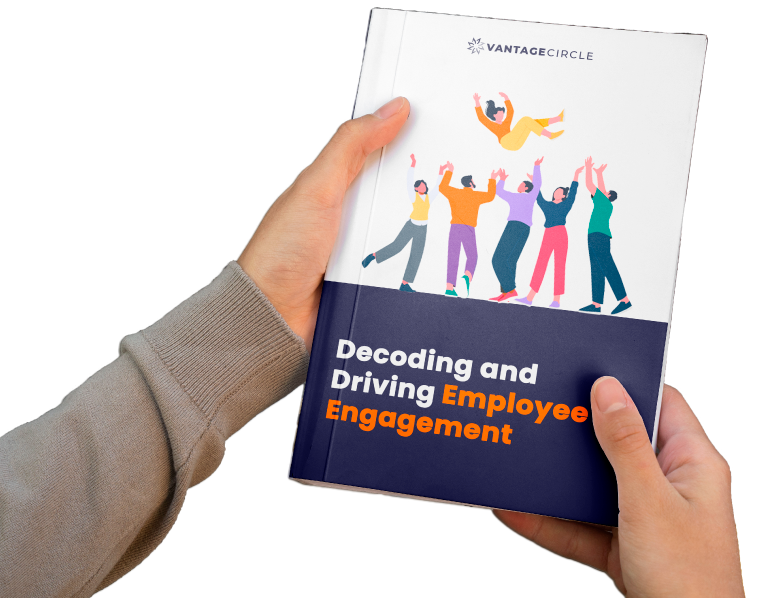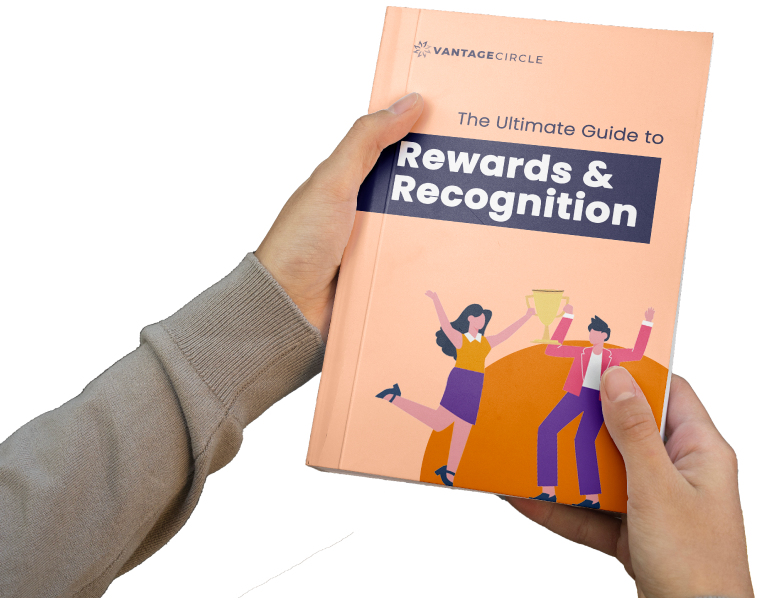Gamification for Employee Engagement: Meaning, Benefits, Ideas, Examples, Tools & Trends
You know that feeling when you can't put down a really good game? That same addictive quality that keeps millions glued to their gaming consoles? We started wondering: What if we could bring that same excitement to the workplace?
Imagine hitting milestones, earning rewards, and feeling a surge of accomplishment with every task you complete. That’s the magic of gamification! It’s not about playing games at work—it’s about using game-inspired elements like points, badges, and friendly competition to make work more fun and fulfilling. From sales teams battling it out on leaderboards to wellness programs where steps turn into rewards, gamification is reshaping how we engage with work. Ready to see how this can transform your workplace? Let’s dive in!
Understanding Gamification in Employee Engagement
What exactly is gamification at work? It’s like bringing the best parts of games—points, badges, leaderboards, and rewards—into your daily tasks. Imagine turning routine goals into exciting challenges where every win is celebrated. At its core, gamification taps into our natural drive for competition, achievement, and recognition, making work not just productive but genuinely enjoyable. It’s not about playing games; it’s about making your workplace feel more rewarding and motivating, one task at a time.
Why Gamify? The Benefits Unveiled
Gamification isn’t just a buzzword—it’s a game-changer for workplaces. By weaving game-like elements into daily activities, companies can unlock incredible benefits that go beyond just having fun. Let’s break it down:
Increased Motivation and Productivity
Turning ordinary tasks into exciting challenges can inspire employees to give their best. Completing goals feels rewarding, and healthy competition can drive productivity to new heights.
Check out ourEmployee Motivation guide to provide your team the necessary motivation.
Enhanced Learning and Skill Building
Who says training must be dull? Interactive quizzes, engaging modules, and friendly contests make learning enjoyable and memorable, helping employees pick up new skills faster.
Better Employee Retention
When work feels rewarding and employees feel appreciated, they’re more likely to stick around. Gamification creates a sense of accomplishment and belonging, reducing the desire to leave.
To know more about the benefits of employee retention check out our blog 14 Amazing Benefits of Employee Retention for Business Success
A Thriving Company Culture
By encouraging collaboration and friendly rivalries, gamification fosters a lively, team-oriented environment. It’s a powerful way to build morale and strengthen bonds among coworkers.
Gamification is more than a strategy—it’s a way to energize the workplace, making it a place employees are excited to be part of. Ready to take the plunge?
Practical Gamification Ideas and Tactics
Injecting a dose of gamification into your workplace can revitalize employee engagement and create a more dynamic work environment. Here are actionable ideas to kick-start your strategy, with tools like Vantage Circle and Vantage Fit to help you along the way.
Points, Badges, and Leaderboards: The Holy Trinity
Points: Assign points for completing tasks, hitting milestones, or demonstrating positive behaviors.
Badges: Recognize achievements by awarding digital badges for milestones, skill mastery, or outstanding contributions.
Leaderboards: Showcase top performers and ignite healthy competition. Team-based leaderboards can further strengthen collaboration while keeping the atmosphere friendly and inclusive.
Fun fact: According to a Gallup study, organizations with highly engaged employees are 21% more profitable.
Challenges and Quests: Epic Engagement Adventures
Challenges: Roll out short-term challenges linked to project goals or wellness initiatives, such as step count contests through Vantage Fit.
Quests: Design multi-step "quests" for complex projects, rewarding participants at each stage for sustained engagement.
Narrative Integration: Add a story element to your challenges—employees could be heroes on a mission, adding excitement and purpose to their tasks.
A study by TalentLMS found that 89% of employees feel more productive and happier with gamified work environments
Progress Bars and Levels: Visualizing the Journey
Progress Bars: Show employees how far they've come with visual indicators tracking their progress toward goals. This keeps motivation high and goals within sight.
Level Up: Implement a leveling system where employees unlock new perks, responsibilities, or recognitions as they progress. For example, reaching new levels could unlock exclusive rewards.
Personalized Rewards and Recognition: Celebrating Victories
Tailored Rewards:
Offer a mix of rewards that cater to diverse employee preferences—think gift cards, extra leave, or personalized experiences. There are different platforms to help streamline this process, making it easy to reward your team.
Recently, at Vantage circle, we introduced a fantastic initiative where we can select our rewards from a variety of goodies available on our intranet portal. It was a thoughtful way to ensure we got items that were truly useful and meaningful to us.
Meaningful Recognition: Celebrate wins both big and small. Use tools to publicly acknowledge contributions or send private notes of appreciation to make employees feel valued.
Stat Spotlight: 69% of employees would work harder if they felt their efforts were better recognized, according to a survey by SurveyMonkey.
By incorporating these gamification tactics and leveraging tools like Vantage Circle and Vantage Fit, you can create a workplace culture that motivates, engages, and inspires your team to thrive.
Examples of Gamification at Work
Gamification isn’t just a concept—it’s a proven strategy in action across various workplace functions. Let’s explore how organizations are making work more engaging with gamification:
Sales Teams: Energizing Targets
Transform sales goals into thrilling challenges by awarding points for deals closed or client follow-ups. Use leaderboards to display progress and foster friendly competition among team members. For top performers, reward them with incentives like bonuses, exclusive perks, or recognition.
Example: A company implemented a points-based system where sales reps earned rewards for exceeding targets, leading to a 30% increase in quarterly revenue.
Customer Service: Recognizing Excellence
Create a recognition system where badges are awarded for exceptional customer satisfaction ratings or speedy resolution of challenging issues. This boosts morale and encourages employees to go above and beyond.
Onboarding: Making First Days Fun
Turn onboarding into an interactive adventure with gamified modules, quizzes, and challenges that teach company values, policies, and tools. New hires can earn badges for completing milestones, making the process both enjoyable and efficient.
Example: A tech firm gamified its onboarding with quizzes and tasks, resulting in a 50% faster integration of new employees into their roles.
Training and Development: Building Skills with Fun
Incorporate game mechanics like points, leaderboards, and badges into training sessions. Employees can earn rewards for completing modules, acing quizzes, or attending workshops. Vantage Fit can gamify wellness training, encouraging participation and knowledge retention.
Gamified training programs can boost employee engagement by up to 60%, according to research by TalentLMS.
By applying these gamification examples, you can inspire enthusiasm, improve performance, and create a workplace where employees are motivated to achieve their best. With tools like Vantage Circle and Vantage Fit, implementing these strategies is easier than ever!
Gamification Tools and Platforms
Implementing gamification is easier when you have the right tools. While basic tools like spreadsheets can work for small-scale initiatives, dedicated platforms provide a seamless experience with advanced features and analytics. Here’s a closer look:
Vantage Circle: Reward and Recognition Reimagined
Vantage Circle is a comprehensive platform designed to transform the way companies engage their employees. It offers:
Customizable Reward Programs: Tailor rewards to fit your company culture and individual preferences, from gift cards to exclusive experiences.
Social Recognition Features: Encourage peer-to-peer appreciation, fostering a culture of acknowledgment and connection.
Performance-Driven Gamification Tools: Use points, badges, and leaderboards to motivate employees and drive desired behaviors.
Streamlined Administration: Simplify the process of managing recognition programs and reward distribution.
Data Insights: Access valuable analytics to understand employee motivation and engagement trends better.
By leveraging Vantage Circle, companies can create personalized, meaningful gamification experiences that boost morale, productivity, and retention.
Other Notable Platforms for Gamification
If you’re looking for additional options, consider these trusted platforms:
Badgeville: Focuses on gamifying user engagement with tools to drive learning and performance.
Bunchball (Nitro): Ideal for integrating gamification into existing applications and workflows, offering scalable solutions for businesses of all sizes.
Spinify: Specializes in gamifying sales and performance metrics with real-time leaderboards and custom challenges to motivate teams.
Pro Tip: Pairing tools like Vantage Circle with other specialized platforms can help create a multi-faceted gamification strategy tailored to your company’s unique needs.
Choosing the right platform can make all the difference in your gamification journey, enabling you to drive engagement, boost morale, and foster a thriving workplace culture.
Trends and Future of Employee Gamification
Gamification continues to evolve, bringing exciting opportunities to redefine employee engagement. Here’s a look at the key trends shaping its future:
VR and AR Integration: Immersive Engagement
Virtual and augmented reality are revolutionizing gamification by creating deeply engaging, interactive experiences. From virtual reality training simulations that mimic real-world scenarios to AR-powered team-building games, these technologies make learning and collaboration both impactful and fun.
Example: A manufacturing company used VR to train employees on machinery operation, reducing errors by 30% and cutting training time in half.
Personalized Gamification Experiences: Tailored to Thrive
The one-size-fits-all approach is giving way to personalization. By tailoring challenges, rewards, and feedback to individual preferences and learning styles, organizations can ensure every employee feels valued and motivated. Personalized gamification adapts to individual goals, making the experience more meaningful and effective.
Stat spotlight: 78% of employees say being recognized based on their unique contributions boosts their motivation.
AI-Powered Gamification: Smarter Engagement
Artificial intelligence is taking gamification to the next level. AI can analyze employee behavior and preferences to:
Personalize challenges and rewards.
Optimize game mechanics in real time.
Provide instant, data-driven feedback to help employees improve continuously.
For example, AI-driven gamification systems can identify when an employee might be disengaged and introduce tailored incentives to re-ignite their interest.
The Road Ahead
Gamification isn’t just a trend—it’s a long-term strategy to build vibrant, motivated workplaces. To make the most of it:
Start small but think big, experimenting with simple mechanics before scaling up.
Actively gather employee feedback and iterate your approach.
Stay updated with emerging technologies to keep your gamification initiatives fresh and relevant.
As the workplace evolves, gamification will remain a powerful tool to engage employees, drive performance, and create a culture where everyone thrives.
















